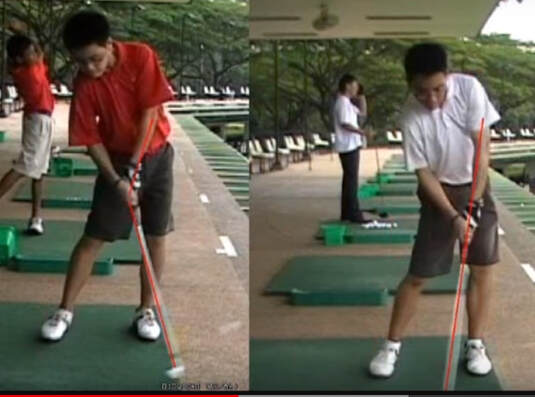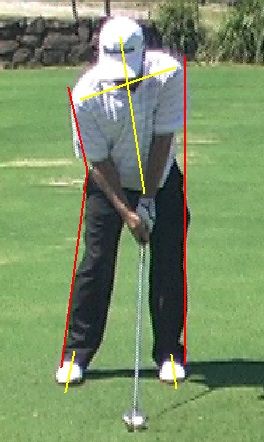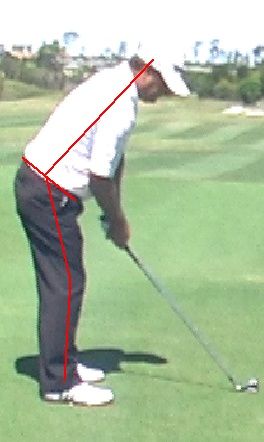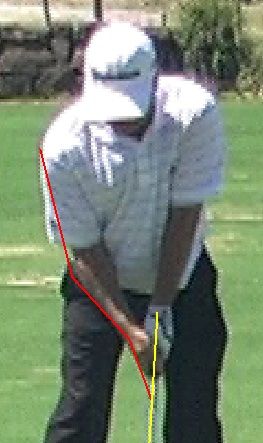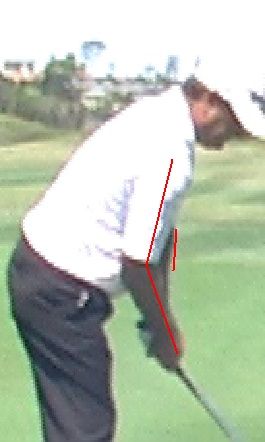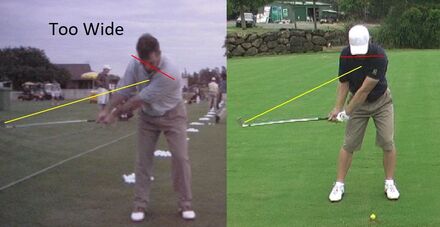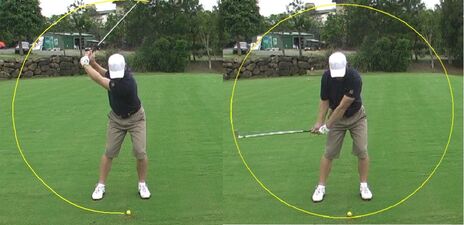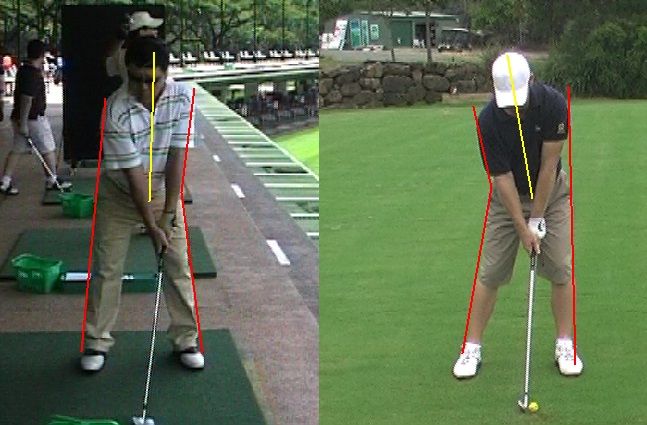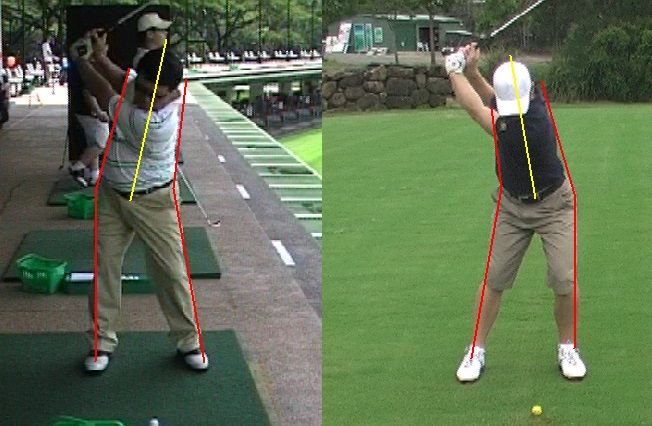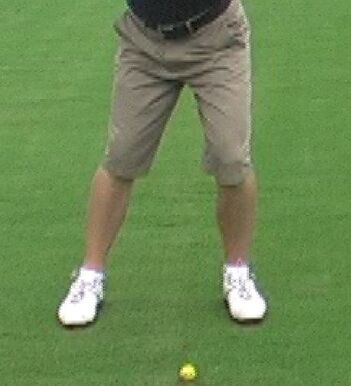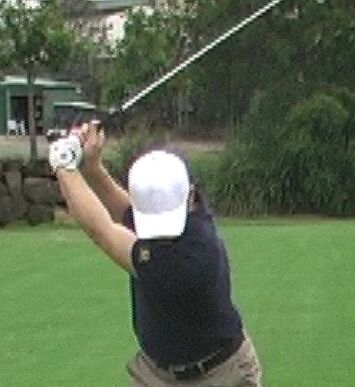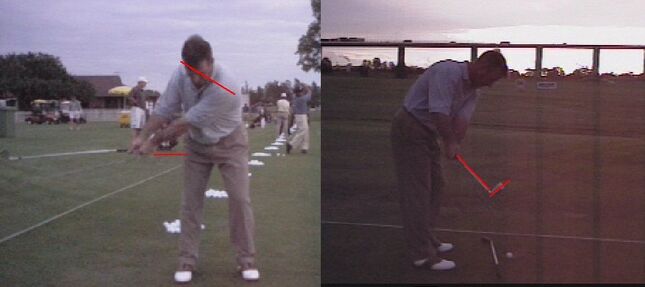the right sided swing
The RSS is an extremely effective way to swing a golf club. It has a proven track record with multiple victories on the PGA Tour, European Tour, Australasian Tour, Asian Tour and many others. Thousands of amateur golfers are using this method and seeing amazing improvements in their games. The swing is suitable for beginner golfers to Tour professionals and any level of golfer in between. Male, female, short, tall, juniors and senior golfers.
If you have 2 arms and 2 legs you can adopt this swing.
The concept of the RSS is quite simple in that we set the golfer up in what is essentially their impact position. From here it makes it very easy for the golfer to make an efficient swing with minimal movements and effort to achieve the perfect impact conditions. There are only 4 concepts you need to understand to see improved impact conditions as seen in this example below.
If you have 2 arms and 2 legs you can adopt this swing.
The concept of the RSS is quite simple in that we set the golfer up in what is essentially their impact position. From here it makes it very easy for the golfer to make an efficient swing with minimal movements and effort to achieve the perfect impact conditions. There are only 4 concepts you need to understand to see improved impact conditions as seen in this example below.
the 4 concepts you need to learn
1. The Set up
The emphasis is based on getting the set up angles correct as all incorrect movements in any golf swing are a result of the set up. The set up entails the wrists and arms, body shape and posture.
The emphasis is based on getting the set up angles correct as all incorrect movements in any golf swing are a result of the set up. The set up entails the wrists and arms, body shape and posture.
2. Swing Radius
Radius is a term we use to describe the distance the clubhead is from our swing centre at address and during the swing. It is impossible to move the body and club correctly with out an understanding of radius. In the RSS, the radius is one of the most important factors as it effects turn direction and weight shift. In essence the understanding of this principle can fix every problem in any golf swing.
Radius is a term we use to describe the distance the clubhead is from our swing centre at address and during the swing. It is impossible to move the body and club correctly with out an understanding of radius. In the RSS, the radius is one of the most important factors as it effects turn direction and weight shift. In essence the understanding of this principle can fix every problem in any golf swing.
3. The Turn
The most important thing about turn is where it starts or the origin.
The direction of turn is a most important factor in the RSS.
In the RSS the turn is related to the angle of the spine. Turn in the RSS maintains the angle of the spine from both the front and behind angles.
With out the proper angles at address it is impossible for students to turn in the right direction. Posture and body shape at address are the major factors that influence turn.
The concepts of radius and weight shift also effect the direction of turn once the motion has begun.
The most important thing about turn is where it starts or the origin.
The direction of turn is a most important factor in the RSS.
In the RSS the turn is related to the angle of the spine. Turn in the RSS maintains the angle of the spine from both the front and behind angles.
With out the proper angles at address it is impossible for students to turn in the right direction. Posture and body shape at address are the major factors that influence turn.
The concepts of radius and weight shift also effect the direction of turn once the motion has begun.
4. Weight Shift
In the RSS we describe weight shift in terms of two masses. The Top and Bottom weight.
The bottom weight does not move laterally on the back swing but this does not mean we do not shift weight.
In reality we setup with the top weight (upper half) on our right side and it stays there on the back swing. It is pulled around its original position therefore there is a weight shift but not in a traditional sense. It only occurs consciously on the downswing. It is only a small shift (bump) to the left.
In the RSS we describe weight shift in terms of two masses. The Top and Bottom weight.
The bottom weight does not move laterally on the back swing but this does not mean we do not shift weight.
In reality we setup with the top weight (upper half) on our right side and it stays there on the back swing. It is pulled around its original position therefore there is a weight shift but not in a traditional sense. It only occurs consciously on the downswing. It is only a small shift (bump) to the left.
is there anything else ?
Of course there are other things to consider in the golf swing. The swing plane, club face, angle of attack etc.
These are just "symptoms" or the end result of something that has gone wrong earlier in the swing.
The cool thing about the RSS is that we never try to fix any of these things in isolation. We know that problems such as club face open or shut, hitting up on the ball, shaft coming in too steep, over the top swing plane and other issues golfers have are all directly related to the 4 concepts above. We can correct any of these issues very quickly by going back to the origin and determining the cause of the problem.
I have hundreds of examples of golfers with swing paths as much as 10 degrees out-to-in who have gone to an in-to-out swing path in just a few balls. By just changing the origin this is very simple to achieve. Golfers that have only ever hit a slice or fade their whole lives can hit draws within minutes.
Without fixing the cause of the problem, the "symptons" are near impossible to fix.
Unfortunately that is what the majority of golfers and instructors try to do with little success.
In 12 years of teaching I have never seen a new student come to me that is set up correctly nor have I ever attempted to fix a swing without starting at the origin.
The example below proves the point. The club face is very closed but this is just the symptom. The cause of the problem is the radius is too wide. You can see how this also effects the golfers turning direction with his shoulders.
To fix the club face all we need to do is fix the radius.
These are just "symptoms" or the end result of something that has gone wrong earlier in the swing.
The cool thing about the RSS is that we never try to fix any of these things in isolation. We know that problems such as club face open or shut, hitting up on the ball, shaft coming in too steep, over the top swing plane and other issues golfers have are all directly related to the 4 concepts above. We can correct any of these issues very quickly by going back to the origin and determining the cause of the problem.
I have hundreds of examples of golfers with swing paths as much as 10 degrees out-to-in who have gone to an in-to-out swing path in just a few balls. By just changing the origin this is very simple to achieve. Golfers that have only ever hit a slice or fade their whole lives can hit draws within minutes.
Without fixing the cause of the problem, the "symptons" are near impossible to fix.
Unfortunately that is what the majority of golfers and instructors try to do with little success.
In 12 years of teaching I have never seen a new student come to me that is set up correctly nor have I ever attempted to fix a swing without starting at the origin.
The example below proves the point. The club face is very closed but this is just the symptom. The cause of the problem is the radius is too wide. You can see how this also effects the golfers turning direction with his shoulders.
To fix the club face all we need to do is fix the radius.
